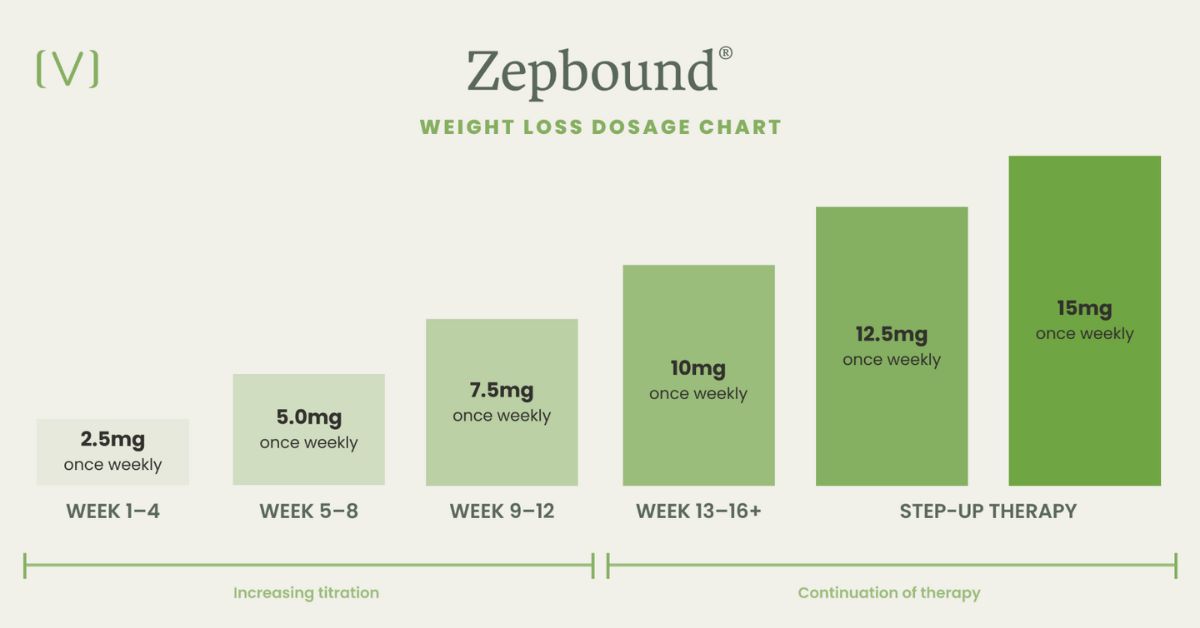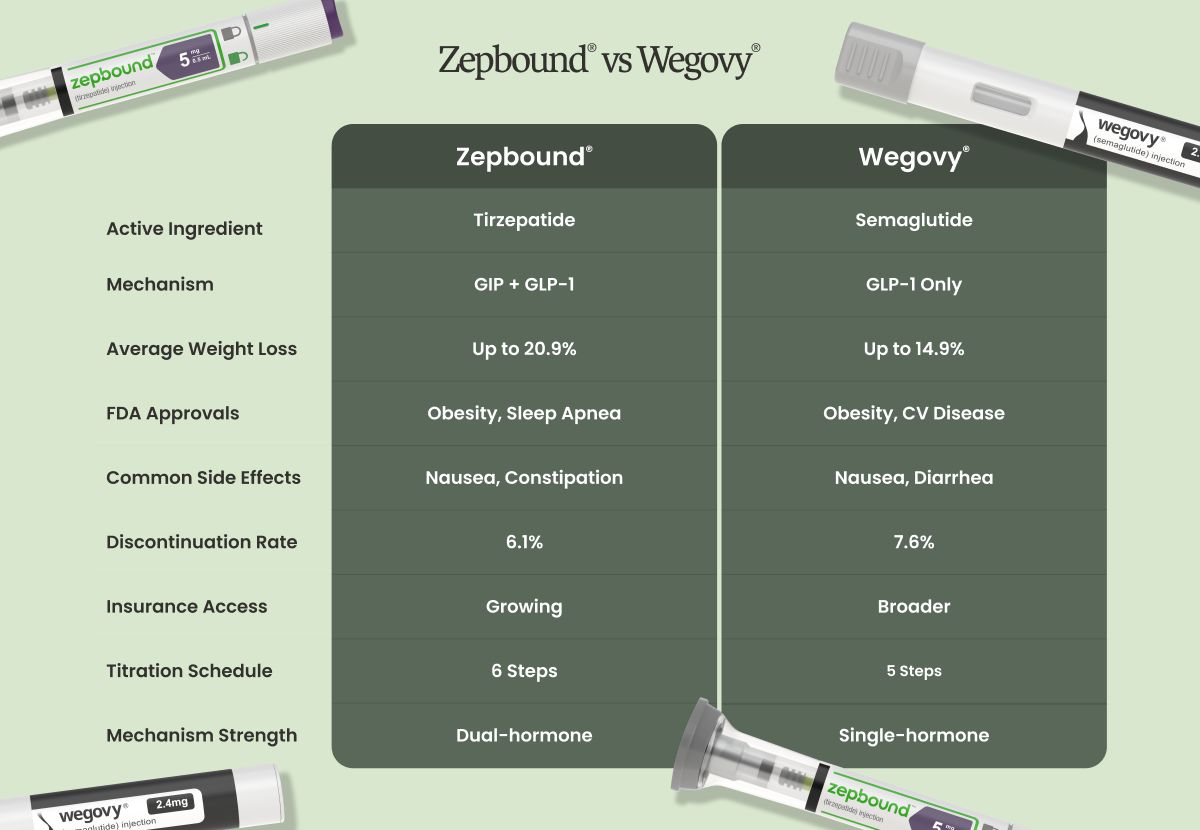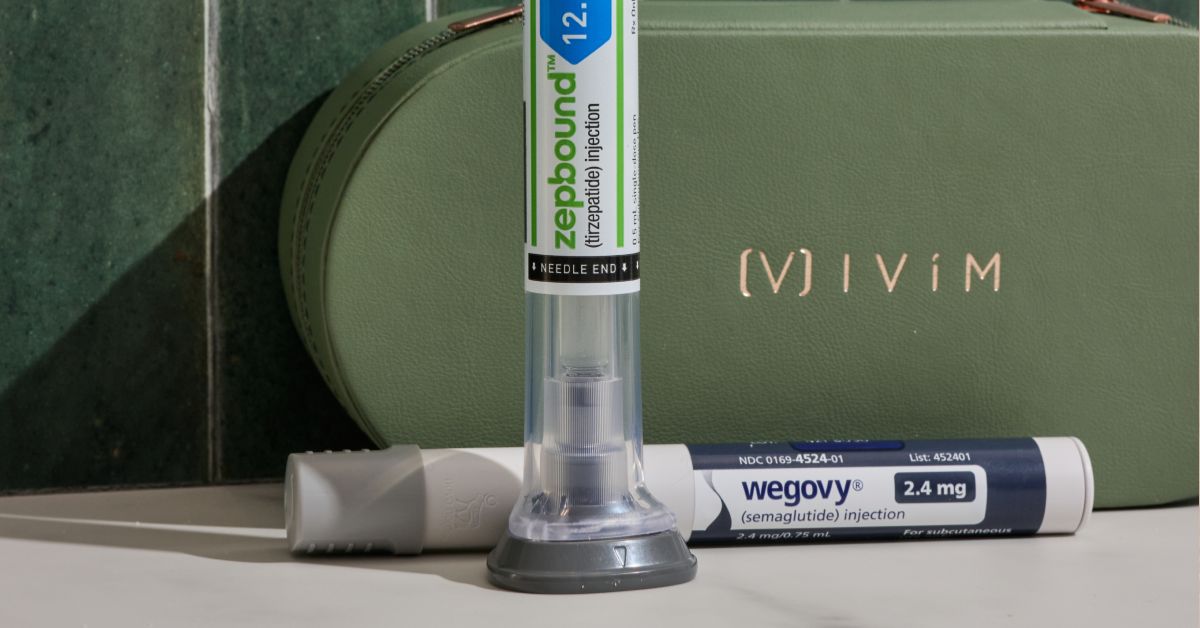Zepbound® vs Wegovy®: What’s the Difference in How They Work, Weight Loss Results, Dosage, Side Effects, and Cost?
If you’re considering prescription support for weight loss, chances are you’ve come across both Zepbound® and Wegovy®. These once-weekly GLP-1 medications are among the most effective treatments available, but while they are similar, there are important differences in how they work, how much weight they may help patients lose, and what conditions they’re approved to treat.
In this guide, we’ll break down the real-world differences between Zepbound® and Wegovy®, including clinical outcomes, side effects, dosing schedules, insurance coverage, and when switching from one to the other might make sense. Whether you’re just starting your GLP-1 journey or looking to fine-tune your plan, this comparison is designed to help you make a well-informed, personalized decision.
What Is the Difference Between Zepbound® and Wegovy®?
What is Zepbound?
Zepbound® (tirzepatide) , works by stimulating both GLP-1 and GIP receptors to enhance metabolic regulation. These hormone receptors help regulate appetite, blood sugar, and how your body uses energy. Together, they send stronger signals to your brain and gut that you’re full, which can reduce hunger, increase satiety, and support long-term weight loss.
In 2023, the FDA approved Zepbound® for long-term weight management in adults living with obesity or excess weight accompanied by a related health issue. In 2024, it was also approved to treat moderate to severe OSA in adults with obesity, and to be used along with a reduced calorie diet and increased physical activity.
What is Wegovy?
Wegovy® (semaglutide) targets the GLP-1 receptor specifically to reduce appetite and slow digestion, helping you feel fuller for longer after meals. Beginning in 2024, the FDA expanded Wegovy®’s approval to include reducing cardiovascular risk in adults with existing heart disease.
Both medications are taken once a week and are designed to support sustainable weight loss when paired with healthy lifestyle changes like nutrition, movement, and restorative sleep.
Zepbound® vs Wegovy® Weight Loss Results
Zepbound® has demonstrated greater average weight loss in clinical trials compared to Wegovy®:
- Zepbound® led to as much as a 20.9% average reduction in body weight at the highest 15 mg dose over 72 weeks, according to results from the SURMOUNT-1 trial.
- Wegovy®: About 14.9% average weight loss at the full 2.4 mg dose in a similar timeframe (STEP 1 trial).
In the SURMOUNT-5 trial, tirzepatide (Zepbound®) resulted in significantly greater weight loss than semaglutide (Wegovy®) in adults with obesity and no history of diabetes. Over a 72-week period, individuals treated with tirzepatide lost an average of 20.2% of their weight, while those on semaglutide saw an average loss of 13.7%.
Both medications also improved metabolic markers such as cholesterol, blood pressure, and waist circumference. For patients aiming for faster or more pronounced weight loss outcomes, Zepbound® may deliver a more powerful impact. For others, Wegovy®’s established cardiovascular benefits may guide the decision.
Zepbound® vs Wegovy® Dosage and Titration Schedule
Both GLP-1 medications use a structured step-up dosing schedule, called titration to reduce side effects.
Zepbound® Dosage (Tirzepatide):

- Start: 2.5 mg weekly for 4 weeks
- Titrate: 5 mg → 7.5 mg → 10 mg → 12.5 mg → 15 mg
For more details, visit our Zepbound® dosing schedule and dosage chart to understand how and when each step is typically administered.
Wegovy® Dosage (Semaglutide):

- Start: 0.25 mg weekly for 4 weeks
- Titrate: 0.5 mg → 1 mg → 1.7 mg → 2.4 mg
Wegovy® uses a structured four-step dose increase, with timing recommendations between each level. For full details on timing, dose increases, and guidance, see our Wegovy® dosing schedule and dosage chart.
Wegovy® vs Zepbound® Side Effects
Both Wegovy® and Zepbound® can cause mild to moderate digestive side effects, like nausea, especially during the first few weeks. Everyone’s experience is different, and some people tolerate one medication better than the other.
Most common side effects include:
- Diarrhea or constipation
- Bloating and gas
- Headache or fatigue
- Reflux or burping
Less common effects may include:
- Dizziness
- Injection site reactions
- Taste changes
- Hair thinning
Some patients find adding supportive supplements such as magnesium, electrolytes, and high-quality whey protein can help ease side effects and support better outcomes.
Want to learn more about safety considerations? Visit our safety guide here.
How Much Do Wegovy® and Zepbound® Cost?
Insurance coverage for GLP-1 medications can vary, but there are several ways to lower your out-of-pocket expenses:
Cost-saving strategies:
- Use FSA/HSA funds
- Apply for manufacturer copay cards (for commercial insurance)
- Obtain prior authorization through your provider
- Work with a clinic that provides insurance navigation
Wegovy® is currently more likely to be covered, especially for patients with cardiovascular disease. However, Zepbound®’s sleep apnea approval may open new coverage pathways, depending on insurer policies. Payers are starting to expand coverage criteria as real-world outcomes and employer demand for obesity care increases.
Understanding the Ivim Health Membership
At Ivim Health, patients gain access to GLP-1 medications like Wegovy® and Zepbound® through a membership-based care model.
What’s included in Ivim membership:
- Personalized provider care & eligibility evaluation
- Ongoing prescription management
- Insurance navigation & prior authorization support
- Safe support for switching between medications when needed
- Lifestyle strategies and behavior change coaching
Your team can guide you on incorporating supplements into your routine, if appropriate with the goal of maintaining muscle, supporting overall wellness, and helping you feel your best throughout your GLP-1 journey.
Switching Between Wegovy® and Zepbound®
Yes, you can safely switch from Wegovy® to Zepbound®, or vice versa, under medical supervision and when guided by a knowledgeable provider. Both medications belong to the GLP-1 class, but they differ slightly in their mechanisms, dosing schedules, and tolerability profiles. Switching may be considered for several reasons, including:
- Inadequate weight loss results
- Side effect intolerance
- Changes in insurance coverage
- Plateauing on current medication
- Seeking stronger appetite suppression or satiety
Most transitions involve cross-titration, gradually adjusting doses to minimize gastrointestinal side effects and support a smooth switch. Your provider may recommend targeted supplements, such as whey protein, magnesium, or electrolytes, to help support muscle health and address potential nutrient gaps that can occur with reduced appetite or side effects during GLP-1 therapy. With the right clinical guidance, switching can be a strategic next step toward achieving your long-term health goals.
Zepbound® vs Wegovy®: Comparison Table

Which GLP-1 Is Right for You – Zepbound® or Wegovy®?
There’s no one-size-fits-all answer. The right choice depends on your health goals, medical history, and insurance coverage. Both medications are highly effective, but they work a little differently, and that can make a difference in your journey.
You might lean towards Zepbound® if:
- You’re dealing with obstructive sleep apnea
- You’ve hit a plateau on another GLP-1 like Wegovy®
- You’re looking for more powerful appetite control
- You still feel hungry, even while on medication
Wegovy® may be the better fit if:
- You have cardiovascular disease and want a medication that supports heart health
- You’ve had success with semaglutide in the past
- Your insurance is more likely to cover Wegovy®
The good news? Both options can support lasting weight loss, better energy, and improved metabolic health, especially when combined with personalized care, lifestyle coaching, and the right supplement support. Your Ivim Health team is here to help you choose the path that fits you best.
Explore Personalized Weight Loss Support at Ivim Health
Both Zepbound® and Wegovy® offer powerful support for long-term weight loss and metabolic health. Understanding how they differ in dosing, mechanisms, and outcomes can help you choose the right fit for your needs.
Not sure which is right for you? The team at Ivim Health is here to help, offering expert guidance on medication eligibility, insurance coverage, and science-backed supplements to support you while on GLP-1 therapy.
Reviewed by Emily Bigby, MD, Physician with Ivím Health
Disclaimer:
This content is for informational purposes only and is not a substitute for medical advice. Always consult your healthcare provider before starting or switching medications.
Zepbound® is a registered trademark of Eli Lilly. Ivím is not affiliated with Eli Lilly. Wegovy® is a registered trademark of Novo Nordisk. Ivím is not affiliated with Novo Nordisk.
Sources:
- U.S. Food and Drug Administration. “FDA Approves New Medication for Chronic Weight Management.” FDA, 8 Nov. 2023, www.fda.gov/news-events/press-announcements/fda-approves-new-medication-chronic-weight-management.
- U.S. Food and Drug Administration. “FDA Approves New Medication for Chronic Weight Management.” FDA, 20 Dec. 2024, www.fda.gov/news-events/press-announcements/fda-approves-new-medication-chronic-weight-management.
- U.S. Food and Drug Administration. “FDA Approves First Treatment to Reduce the Risk of Serious Heart Problems Specifically in Adults with Obesity or Overweight.” FDA, 8 Mar. 2024, www.fda.gov/news-events/press-announcements/fda-approves-first-treatment-reduce-risk-serious-heart-problems-specifically-adults-obesity-or.
- Perkovic, Vlado, et al. “Effects of Semaglutide on Chronic Kidney Disease in Patients with Type 2 Diabetes.” The New England Journal of Medicine, vol. 391, no. 1, 24 May 2024, pp. 109–121. NEJM, https://www.nejm.org/doi/full/10.1056/NEJMoa2403347.
- Jastreboff, Ania M., et al. “Tirzepatide Once Weekly for the Treatment of Obesity.” The New England Journal of Medicine, vol. 387, no. 3, 2022, pp. 205–216. https://www.nejm.org/doi/full/10.1056/NEJMoa2206038.
- Wilding, John P.H., et al. “Once-Weekly Semaglutide in Adults with Overweight or Obesity.” The New England Journal of Medicine, vol. 384, no. 11, 2021, pp. 989–1002. https://www.nejm.org/doi/full/10.1056/NEJMoa2032183.
- Frías, Juan P., et al. “Tirzepatide versus Semaglutide Once Weekly in Patients with Type 2 Diabetes.” The New England Journal of Medicine, vol. 385, no. 6, 2021, pp. 503–515. https://www.nejm.org/doi/full/10.1056/NEJMoa2107519.
- Aronne, Louis J., et al. “Tirzepatide as Compared with Semaglutide for the Treatment of Obesity.” The New England Journal of Medicine, vol. 390, no. 19, 11 May 2025, pp. 1801–1814. https://www.nejm.org/doi/10.1056/NEJMoa2416394.
- University of Washington Medicine. “Wegovy Approved for Heart Disease: What It Means.” UW Medicine Newsroom, 14 Mar. 2024, https://newsroom.uw.edu/video-library/wegovy-approved-for-heart-disease-what-it-means.

